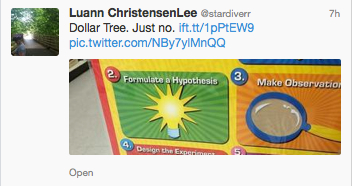You log into Facebook, and there’s THAT friend, the grammar expert. The well-meaning grammar cop who is on a personal mission to correct every grammar or spelling error, ever. The friend who would bring together the programmers who created Autocorrect for a workshop. We accept that person. We love that person, and sometimes we learn from that person. Some of us may or may not recognize ourselves in that person. I am not that person. Oh, no. I have a far more nerdy mission.
I went to Dollar Tree last summer. I was doing some classroom redecorating, and wanted some of those huge cutout letters that elementary teachers always have. I found the letters (I’ll post about that when it’s done, but I’m waiting for my school supply order to be filled to finish decorating). And I found this, on an endcap. (Apologies for the lousy photo. The aisle was kind of busy.)

I may have cringed a little. While I am eternally grateful to the Dollar Tree for providing great stuff for my classroom (more about my other great purchase of the day later) Local children might be exposed to this, and later end up in my classroom, where I’ll have to spend hours of time we could otherwise spend doing cool things to erase this idea from their minds. I posted it on Instagram and Facebook, where a few former students and science teacher colleagues offered up critiques, such as, “That’s an old, incorrect model of the atom.” “Where is the data that will be interpreted?” and, simply. “Ugh.” Can you spot the misconceptions?
Then, I posted on Twitter: 
And I got a reply.

I was quite impressed that someone monitoring their twitter account was interested in updating their products. An interesting conversation took place, ending with my agreeing to suggest updates to the poster. The science community has begun to refute any one single “scientific method.” Rhett Allain, in Wired, explains how some scientists work – and how they do not.
The new Next Generation Science Standards offer up a set of Science and Engineering Practices outlining what students should know and be able to do when learning science, listed below.
- Asking questions (for science) and defining problems (for engineering)
- Developing and using models
- Planning and carrying out investigations
- Analyzing and interpreting data
- Using mathematics and computational thinking
- Constructing explanations (for science) and designing solutions (for engineering)
- Engaging in argument from evidence
- Obtaining, evaluating, and communicating information
Note the lack of a set process with the terms hypothesis, conclusion, and surprisingly, inquiry. Not all investigative work students do in science is hypothesis-testing; in fact, very little inquiry involves writing an hypothesis.
The “old,” traditional, textbook version of the scientific method lacks at least two major components: flexibility, and the formation of a model. A model is, simply, a proposed description of explanation of a phenomenon or why or how it works. Once the model is proposed, it is tested with a great many scenarios or situations and modified as needed to explain. The limitations of the model, or aspects that can’t readily be changed, are listed, described, and their impact on understanding are explained. The model can then be a useful learning tool.
A familiar example of a model is our idea of the atom. Dalton proposed an atomic theory, but did not describe the atom itself. Thomson found electrons and proposed the addition of negative charge to the atom. Where was the mass? The positive charge? Rutherford et. al. located a massive, positively charged nucleus, and James Chadwick proposed the existence of a particle having mass but no charge – the neutron. Many other iterations of the structure of an atom were proposed, questioned, investigated, and documented until the currently-held quantum mechanical model of the atom was developed.
The scientific method, then, is officially dead in states who have adopted the Next Generation Science Standards. I know I’m not the only one happy about that. You?

The old scientific method needs to be retired to a green pasture on some distant farm. Students get a mistaken view that science is conducted in a linear fashion only with the old method. Also, I’m impressed Dollar Tree has a twitter handle.
Indeed, Patrick, and impressed that they struck up a conversation. I tagged them in a tweet with this post linked. We’ll see where it goes.
It would be really impressive to see if they would be willing to pull it and put out a more accurate representation.